February has been a month full of interest. More and more plant species are coming into bloom. I had the pleasure of speaking twice – the first in Sierra Vista to the Cochise Chapter of the Arizona Native Plant Society (AZNPS) on “Invisible Flowers and Other Wonders” , and two days later giving a similar speech to the Arizona Botany Meeting 2014, at the Arizona-Sonora Desert Museum, “Taking a Closer Look.” Both talks gave me a chance to share pictures I have taken, some looking at familiar flowers close up, others showing “invisible flowers”, flowers that are so small or insignificant that people walk by them not knowing that they are in bloom. People responded very favorably to the two talks.
At the conference I had the pleasure of making contact with people who share a love of plants, and all things in nature. The day ended with a dinner, and a speech by local raconteur Petey Mesquite, whose radio talks have entertained people for years. He proved to be a most engaging speaker with his stories, pictures and songs. What a delightful way to end the day!
The next day there were optional nature walks. I went on the one led by Jim Verrier. There were about 15 to 17 people on the hike, including some specializing in certain aspects of botany, like sedges and rushes. Everyone had something to contribute to the richness of our experience, and we all shared the love of discovery.
Several times our group gathered around an apparently bare patch of earth, some of us on all fours. People gave us strange looks as they walked by in bewilderment. We were definitely looking at things that they were not seeing.
We found some interesting “invisible” plants, including Mouse-tail (Myosurus cupulatus, in the Ranunculus family). This is a very small plant that grows in wet places in the early spring. I have looked for it in Molino Basin and Gordon Hirayabashi this year without success. Evidently it is too dry there. But we were in Catalina State Park, where there is some water still flowing even though it has not rained much in the last eight weeks. Another small plant is Miner’s lettuce (Claytonia perfoliata), so called because it is an edible little plant and its stems are perfoliate, going right through the center of the leaves. The tiny white flowers come out of the top leaf like a miniature lotus in its lily pad.
Mouse-tail – a plant just a few inches high. The tail grows longer and longer and turns brown.
This is my most recent picture of the flower stalk of Mouse-tail with a penny to show the scale
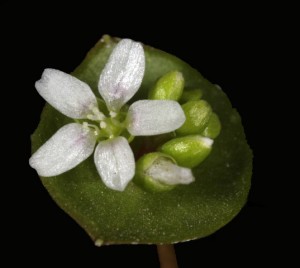 Here is a close up showing the anthers.
Here is a close up showing the anthers.
Miner’s lettuce close up, with one open flower and lots of buds
Looking down on a Miner’s lettuce plant. It is named after John Clayton, an18th century botanist from Virginia.
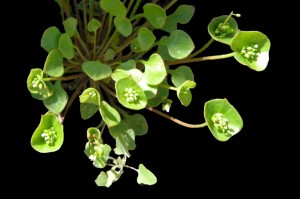
We had two very special plant people on the walk, our leader, Jim Verrier and one of Arizona’s most knowledgeable botanists, Richard Felger. Each of the other people on the hike brought some special knowledge of nature, which made for a very rich and enlightening experience.
We came across just a few examples of another plant that I met in Catalina State Park last year and regretted not finding it with flowers or fruit (Common pussy paws, Cistanthe monandra). Also last year I did not have my super macro lens. We found that the plant was mostly in fruit, but Richard Felger pointed out that there were some very tiny flowers. Its species name “monandra” which means “having only one anther”, which you can see in the picture.
Common pussy paws, a plant in the Portulaca family that looks as if it has been stepped on.
A close up showing lots of fruit on the Common pussy paws.
A very close look at what I think is the flower
NOTES
KXCI presents:
“Growing Native with Petey Mesquitey”
The following is an excellent website for looking up the meaning of plant names:
California Plant Names:
Latin and Greek Meanings and Derivations
A Dictionary of Botanical and Biographical Etymology
Compiled by Michael L. Charters
http://www.calflora.net/botanicalnames/index.html
A recent and excellent website for Arizona flora:
gilaflora.com

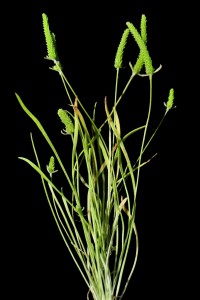
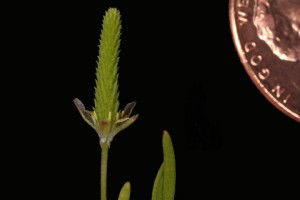
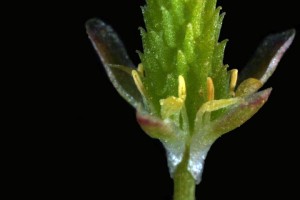

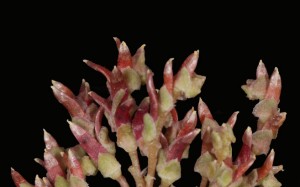
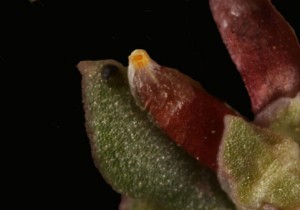
Frank, is the deformation of the crested saguaro a parasite, disease or mutation as far as you know?
Hi Mike: No one I have talked to seems to know. Other cactuses also crest. Mystery. Thanks for asking. Frank